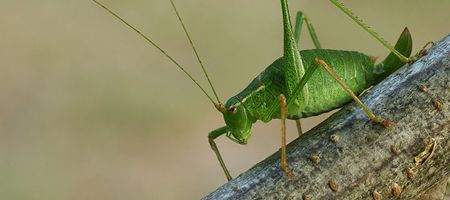Ever wondered what the Jurassic sounded like? One group of paleontologists did. And through analysis of some cricket fossils and comparisons with modern insects, they reckon they’ve found out.

A Chinese team provided a bushcricket fossil from the Mid Jurassic periodwhich had such well-preserved wing features that – for the first time ever – the details of its stridulating organs were clearly visible under an optical microscope.
It was identified as a new fossil species and named Archaboilus musicus by the international team.
Dr Fernando Montealegre-Zapata and Professor Daniel Robert of the University of Bristol examined the anatomical construction of the fossil’s song apparatus, and compared it to 59 living bushcricket species.
They concluded that this animal must have produced musical songs, broadcasting pure, single frequencies.
“This discovery indicates that pure tone communication was already exploited by animals in the middle Jurassic, some 165 million years ago. For Archaboilus, as for living bushcricket species, singing constitutes a key component of mate attraction,” says Professor Robert.
“Singing loud and clear advertises the presence, location and quality of the singer, a message that females choose to respond to – or not. Using a single tone, the male’s call carries further and better, and therefore is likely to serenade more females. However, it also makes the male more conspicuous to predators if they have also evolved ears to eavesdrop on these mating calls.”
Amazingly, based on the detailed morphology of Archaboilus’ wings, Dr Montealegre-Zapata says he’s reconstructed the songs emitted by these ancient insects.
He established that A. musicus sang a tone pitched at 6.4kHz and that every bout of singing lasted 16 milliseconds. This turned out to be enough information to acoustically reconstruct the song itself – possibly the most ancient known musical song ever documented, the team points out.
“Using a low-pitched song, A. musicus was acoustically adapted to long-distance communication in a lightly cluttered environment, such as a Jurassic forest. Today, all species of katydids that use musical calls are nocturnal so musical calls in the Jurassic were also most likely an adaptation to nocturnal life,” says Dr Montealegre-Zapata.
“Being nocturnal, Archaboilus musicus probably escaped from diurnal predators like Archaeopterix, but it cannot be ruled out that Jurassic insectivorous mammals like Morganucodon and Dryolestes also listened to the calls of Archaboilus and preyed on them.”






